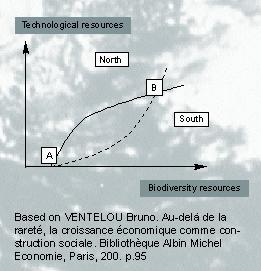
Edition 12
- November, 2002 |
Pharmaceutical bio-prospecting: What conditions are
needed for a North-South partnership? |
Past and present bio-prospecting contracts show us that determining the nature
of a North/South bio-prospecting relationship depends largely on the position
of each group of stakeholders. Analysing the apparently diverging interests
within the framework of the competitive market theory and in the context of
other economic developments can be useful for understanding existing situations
and identifying the conditions necessary for a successful North/South partnership.
This approach responds to the following questions:
- Does the competitive market meet all the conditions
required to ensure on its own an equitable North and South relationship?
- Can a partnership lead the stakeholders to a more
profitable and balanced relation and, if so, under what conditions?
- Are the existing co-ordination and communication tools appropriate for
a partnering approach?
The concept of partnership
Partnership can be defined as a relationship in which each stakeholder benefits
equitably. The benefits and advantages should enable the stakeholders to reach
a better, more independent position. A bio-prospecting partnership can mean
facilitated access to biodiversity for northern companies and access to technology
resources or capacity building for southern stakeholders.
From the theoretical equilibrium of the competitive market to a practical
imbalance
The competitive market theory states that optimum equilibrium is obtained when
the supply meets the solvable demand, if a certain number of hypotheses are
met. But because these hypotheses are not verified, the competitive market cannot
ensure an equitable balance in bio-prospecting activities.
- First hypothesis: The economic agents are rational and maximise their
individual profits
While pharmaceutical companies are economic agents, it is
not sufficient to designate the suppliers as pure economic agents. Indeed,
they are states, which have above all a regulating role, and local
communities, whose social organisation is not generally based on the
commercial use of biodiversity and individual relations.
- Second hypothesis: The object exchanged is merchandise that is divisible,
private and economically valuable
However, biodiversity is a specific good.
First, it is not indefinitely divisible because biodiversity elements are
interdependent. Second, the status of biodiversity depends on international
conventions (TRIPS, Trade-Related Aspects of Intellectual Property Rights,
CBD, Convention on Biological Diversity and ITPGR, International Treaty on
Plant Genetic Resources). Third, the economic value of biodiversity is highly
uncertain. It cannot take into account the principle of irreversibility and is
not able to reflect the social, cultural and local values developed by
communities.
- Third hypothesis: The atomicity of the agents
In reality, the exchange of biodiversity results from a negotiation process
in which the North disposes of a certain strength in terms of industrial concentration,
intellectual property rights (IPR) and availability of information and experts.
The northern stakeholders, therefore, influence the prices and exchange conditions.
These elements show us the limits of the market in ensuring equitable sharing
between the North and the South.
 |
Co-ordination tools: keys for leading the market to an optimum balance
Co-operation can make the competitive market equilibrium more profitable and
equitable.
1. From competition to co-operation
This graph presents two stakeholders and represents the different choices of
capital accumulation they can make: the North accumulates technologies and the
South biodiversity. The relationship between the two resources is positive:
the North’s investment in technology will depend on the South’s
investment in biodiversity and vice versa because biodiversity is understood
as raw material and technology as the means to transform it into an end product.
This positive relation enables us to explain the existence of two equilibriums
on the graph.
- Equilibrium A occurs in a competitive market where
the absence of co-operation leads to an absence of investment on both sides.
Indeed, each actor, uncertain of the investment of the other stakeholder and
acting rationally, prefers not to invest.
- Equilibrium B occurs in a co-operation logic in which the stakeholders co-ordinate
their investment decisions. Following a rational move, the two stakeholders
invest significantly. B is more profitable globally and individually for each
stakeholder.
2. Key condition: building coordination tools
In order to get stakeholders to abandon a competitive logic and enter into a
co-operation scheme, confidence is required, so the creation of co-ordination
and communication tools is a key condition.
The stakeholders have to organise their representation in such a way that it
enables them to defend their interests with similar power. These representatives
are in charge of building institutions for discussions and exchanges of ideas
under equal conditions, which means that the voices are of equal importance.
Agreements and conventions then give decisions a legally binding strength. They
must be clear and unequivocal.
Thus, the co-ordination tools result from the capacity and the choice of the
stakeholders.
The partnership and its co-ordination tools today: criticism and perspectives
The last ten years have shown us an increase of international awareness of
the need to build partnerships. Indeed, stakeholders’ associations such
as non-governmental organisations are taking an active part in the process.
Institutions have been created, and the CBD and its implementation tools –
such as mutually agreed terms to be cast in Material Transfer Agreements (MTA)
– are intended to promote equitable access and benefit sharing (ABS).
- Have these coordination tools really been built to ensure a confident
North/South relation and equitable benefit sharing?
The imbalance between some
economic institutions and conventions and others promoting access and benefit
sharing seems to maintain and not reduce the North-South gap. The three
following points illustrate this imbalance. First, while the World Trade
Organisation can enforce its decisions and impose its rules to the members,
the CBD institutions have no control over the implementation of their
principles. Another example of imbalance lies between the strong degree of
obligation of the IPR and the weakness of the CBD. And, finally, the unclear
relationship between CBD and IPR promotes conflicts and not co-operation
between the stakeholders.
- Perspectives of a partnership?
The existing co-ordination tools are a necessary and good basis for any future
improvements in the building of a partnership. However, these tools and consequently
the partnership depend on the capacity and will of the stakeholders to create
adequate conditions. Today, this partnership faces two obstacles: the reluctance
of the North to insert an explicit sharing obligation in the IPR and the difficulty
of the South to ensure partnership among the southern stakeholders.
Conclusion
The difficulty in building a partnership results from a misunderstanding of
the concept itself. Instead of considering partnership as a source of opportunities
and growth, the stakeholders often view it as a complex relationship that weakens
the protection of their individual interests. The solution is to convince the
stakeholders of the profitability and advantages of a partnership.
Authors:
Stéphanie FRIEBEL, Bachelor in Commercial and Consular Sciences
Philippe Desmeth, BCCM International Programme Officer
This article is based on Bio-prospecting in the pharmaceutical sector: a partnership
between North and South? by Stéphanie Friebel



